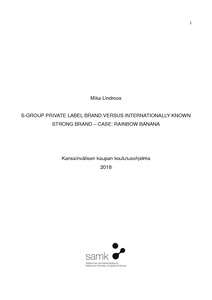| dc.contributor.author | Lindroos, Mika | |
| dc.date.accessioned | 2018-05-23T06:38:51Z | |
| dc.date.available | 2018-05-23T06:38:51Z | |
| dc.date.issued | 2018 | |
| dc.identifier.uri | URN:NBN:fi:amk-201805209103 | |
| dc.identifier.uri | http://www.theseus.fi/handle/10024/147553 | |
| dc.description.abstract | The purpose of this thesis was to find out which product customer chooses between two different strong brands: a private label product or an internationally known strong brand product. The quality of the product has an important role in the customer's decision making process and that is why a qualitatively fragile product, banana, was used in this thesis.
As a detailed topic of this thesis I used Rainbow banana which belongs to S-group’s Rainbow – product assortment and as a comparative product I used internationally well-known Chiquita banana. The purpose of the theoretical part was to research the features of customer-based brand using Kevin Lane Keller’s customer based brand equity model as a base of the study. In addition the studies about customer decision making processes were a significant part of the theoretical background. The material for this was collected from books and Internet. The empirical part of the study was made by using a quantitative research about customer’s everyday decision making process in a grocery store. In addition I used qualitative research methods by interviewing S-group’s experts about private label branding strategies from a customer-based point of view.
There are many different features which guide the decision making process of a customer and the main goal of this study was to find out which one of these products customer chooses to buy: Rainbow banana or strong international brand Chiquita banana. The results gotten from the quantitative research showed the power of a brand and the different features guiding customer’s choice making process. The results will be used for improving the sales and cost efficiency in S- group.
As a result of this study we can note that during past few years there have come new features in building a successful brand. The customer’s price and quality awareness has risen and consumers have better possibilities to get even specific information about the origin and the manufacturing methods of the products. The biggest individual notes of this study were that the prejudices towards private label products’ quality factors are still relatively high and that price has a significant role in choosing between similar alternatives. | en |
| dc.language.iso | eng | |
| dc.publisher | Satakunnan ammattikorkeakoulu | |
| dc.rights | All rights reserved | |
| dc.title | S-group private label brand versus internationally known strong brand - Case: Rainbow banana | en |
| dc.type.ontasot | fi=AMK-opinnäytetyö|sv=YH-examensarbete|en=Bachelor's thesis| | |
| dc.identifier.dscollection | 10024/155 | |
| dc.organization | Satakunnan ammattikorkeakoulu | |
| dc.contributor.organization | Satakunnan ammattikorkeakoulu | |
| dc.subject.keyword | private label | |
| dc.subject.keyword | oman kaupan merkki | |
| dc.subject.degreeprogram | fi=Liiketalous, hallinto ja markkinointi|sv=Företagsekonomi, förvaltning och marknadsföring|en=Business Management, Administration and Marketing| | |
| dc.subject.discipline | Kansainvälinen kauppa | |
